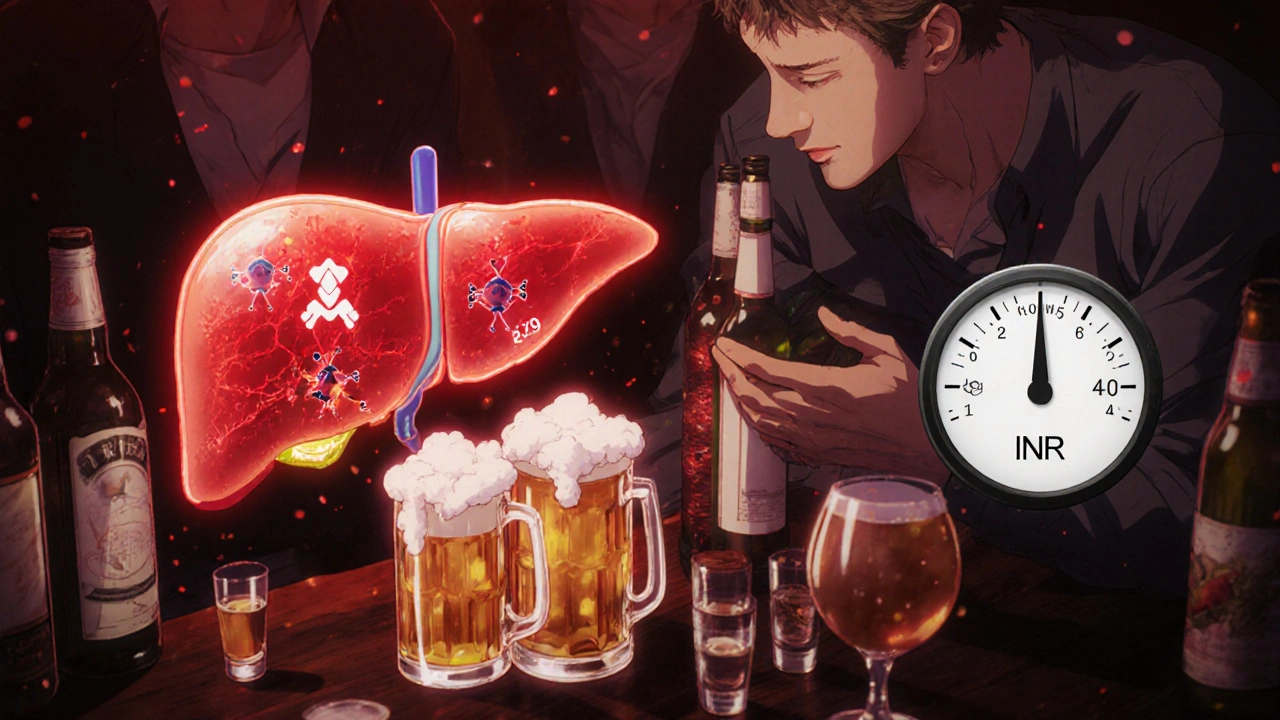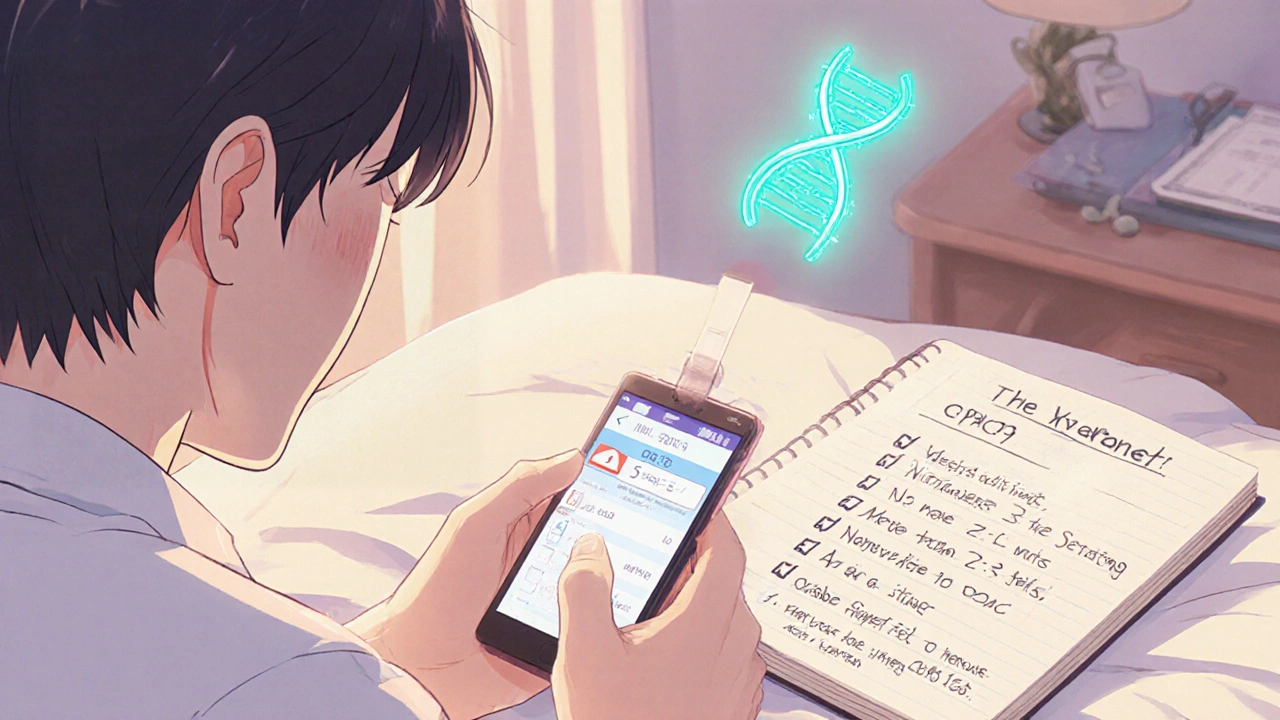Warfarin and Binge Drinking: How Alcohol Flips INR and Boosts Bleeding Risk

Warfarin Alcohol-Binge Risk Calculator
Recommended therapeutic range: 2.0-3.0
1 standard drink = 10ml pure alcohol (12oz beer, 5oz wine, 1.5oz spirits)
When a patient on Warfarin is a vitamin K antagonist anticoagulant used to prevent clots in conditions like atrial fibrillation, deep vein thrombosis and pulmonary embolism, any sudden change in blood chemistry can tip the balance from safe to hazardous. One of the most unpredictable triggers is Alcohol Binge Drinking, defined as five or more drinks for men (four for women) within about two hours. That quick surge of alcohol can send the International Normalized Ratio (INR) soaring, opening the door to serious bleeding. Below is a practical guide to what happens, why it matters, and how to stay safe.
Why Warfarin Needs a Tight INR Window
Warfarin works by blocking vitamin K‑dependent clotting factors. The therapeutic INR range for most indications sits between 2.0 and 3.0. Stay inside that window and you keep clots at bay without inviting unwanted bleeding. Slip below 2.0 and the clot‑prevention effect wanes; climb above 3.0 and even a minor cut can turn into a hemorrhage.
What Happens Inside Your Body When You Binge Drink?
Alcohol hits the liver hard, and the liver is the control center for warfarin metabolism. Two opposing forces come into play:
- Acute inhibition: A single binge competes for the CYP2C9 and CYP3A4 enzymes that break down warfarin, slowing clearance and causing a rapid INR rise.
- Chronic induction & damage: Repeated heavy drinking pushes the liver to produce more of those same enzymes and, over time, damages liver cells that synthesize vitamin K‑dependent clotting factors. The result is an erratic INR that can swing high or low without warning.
Studies back this up. A 2015 case‑control study of 1,200 warfarin patients found binge drinkers had a 2.3‑fold higher odds of a major bleed. When binge drinking was combined with the CYP2C9*2 or *3 genotypes, the risk jumped to more than four times the baseline.
Genetic Factors: When Your DNA Calls the Shots
Not everyone metabolises warfarin the same way. The CYP2C9*2 variant slows metabolism by about 30‑50%, while CYP2C9*3 can cut it by up to 90%. Add a binge episode and the INR can sky‑rocket within 24‑48 hours. If you know you carry one of these alleles, the safest play is tighter INR monitoring after any alcohol intake, or even switching to a direct oral anticoagulant (DOAC) that has fewer diet‑drug interactions.
How Much Alcohol Is Too Much?
Guidelines differ by country, but the consensus for warfarin patients is clear: keep alcohol spread out, never pack it into a single session.
| Group | Maximum weekly units | Maximum per occasion |
|---|---|---|
| General healthy adults | 14 units | 7 units (≈3‑4 drinks) |
| Warfarin patients (NHS/UK guidance) | 14 units | Never more than 2‑3 units in one sitting |
| Patients with CYP2C9*2/*3 | ≤7 units | Maximum 1‑2 units per occasion |
One unit equals roughly 10 ml of pure alcohol-about a small glass of wine or a half‑pint of beer. The key phrase is “never more than 2‑3 units in one sitting” for anyone on warfarin.

Spotting the Red Flags: When to Call the Doctor
Bleeding can show up in many ways. Keep an eye out for:
- Unexplained bruises or large bruises from minor bumps
- Persistent nosebleeds or gum bleeding
- Blood in urine, stool (black/tarry), or vomit (coffee‑ground)
- Sudden severe headache, abdominal pain, or dizziness
- Heavy menstrual bleeding or prolonged bleeding from cuts
If any of these appear after a night of heavy drinking, get medical help right away and have your most recent INR result ready.
Practical Steps for Patients Who Drink
- Tell your clinician: Document any binge episodes, even if they seem occasional.
- Increase monitoring: Schedule an INR test within 72 hours after a binge. Some clinics advise a temporary dose reduction of 10‑20% if the INR spikes above 3.5.
- Use a tracking app: Many anticoagulation apps let you log drinks alongside INR values, creating a clear picture for your care team.
- Consider genotype testing: If you haven’t already, ask about CYP2C9 testing; it’s a quick blood draw that can guide dosing.
- Explore alternatives: For patients with regular alcohol use, DOACs such as apixaban or rivaroxaban may be safer, though they still carry bleeding risk with heavy alcohol.
- Seek support for alcohol misuse: Integrated care models that combine addiction counseling with anticoagulation clinics have cut major bleeding events by half in recent trials.
Follow‑up is crucial. If your INR stays out of range for more than a week, your provider may adjust the warfarin dose or switch therapy.
Role of Healthcare Teams: What Clinicians Should Do
Providers often miss the alcohol‑warfarin link because the FDA removed the black‑box warning in 2010. Modern practice should include:
- Routine AUDIT‑C screening at every anticoagulation visit (USPSTF recommends at least annual screening).
- Electronic health record alerts (e.g., Epic’s 2023 alcohol‑warfarin module) that flag patients with a positive screen and suggest a 48‑hour INR check.
- Structured patient education: a brief, repeated counseling session reduces warfarin‑related bleeds by around 37% (WAVE trial).

When to Switch Off Warfarin
If binge drinking is a persistent pattern despite counseling, or if the patient carries high‑risk genotypes, switching to a DOAC is often recommended. However, DOACs are not a free pass-heavy alcohol still raises gastrointestinal bleed risk. The decision should balance clot prevention, liver health, and the patient’s ability to adhere to medication timing.
Quick Checklist for Warfarin Patients Who Drink
- Know your weekly unit limit (≤14 units, spread out).
- Never consume >2‑3 units in a single sitting.
- Log every drink in a diary or app.
- Get an INR test within 72 hours after any binge.
- Watch for the bleeding red flags listed above.
- Discuss genotype testing and possible switch to a DOAC with your doctor.
- Seek help for alcohol use disorder if you can’t cut back.
Bottom Line
Even a single night of heavy drinking can push the warfarin and alcohol interaction into dangerous territory. By understanding the mechanisms, staying vigilant about INR changes, and working closely with your healthcare team, you can keep the bleeding risk low while still enjoying a responsible social life.
Can I have a glass of wine while on warfarin?
Yes, a single standard glass (about 5 oz) is generally safe if you keep it within the recommended weekly limit and avoid bingeing. Always check your INR after any new drinking habit.
How soon should I get an INR test after a binge?
Most guidelines suggest an INR check within 72 hours. Some clinics may test earlier if you notice any bleeding signs.
What is the difference between a unit and a drink?
One unit equals 10 ml of pure alcohol. A typical 12‑oz beer (5% ABV) is about 1.4 units, a 5‑oz glass of wine (12% ABV) is about 1.7 units, and a 1.5‑oz shot of spirits (40% ABV) is roughly 1 unit.
Do DOACs eliminate the alcohol risk?
DOACs have fewer food‑drug interactions, but heavy alcohol still increases gastrointestinal bleeding risk, especially with rivaroxaban. They are safer for moderate drinking, not a free pass for bingeing.
Should I get genetic testing for CYP2C9?
If you have a history of variable INR or you plan to drink occasionally, ask your clinician about CYP2C9*2/*3 testing. It helps tailor warfarin dosing and informs alcohol‑related risk.
Mary Mundane
October 24, 2025 AT 18:01Binge drinking while on warfarin is a fast track to an unsafe INR spike; keep alcohol intake modest and spread out.
Amanda Vallery
October 24, 2025 AT 23:34U should avoid heavy drinking if u are on warfarin, it can raise INR quickly.
Marilyn Pientka
October 25, 2025 AT 07:54It is ethically indefensible to treat oneself to a binge when anticoagulants are in play; the pathophysiological interplay between CYP450 inhibition and coagulation factor synthesis creates a perilous hypercoagulable‑hypocoagulable dichotomy. Such imprudent conduct disregards the fiduciary duty one owes to personal health and to the medical professionals tasked with monitoring therapeutic windows. The risk calculus is not a mere statistical abstraction but a concrete threat of gastrointestinal or intracranial hemorrhage. In the lexicon of pharmacodynamics, one would label this behavior as non‑adherence of a catastrophic magnitude.
Jordan Levine
October 25, 2025 AT 19:01Stop bingeing, it’s a recipe for disaster! 😡
Carla Taylor
October 26, 2025 AT 08:54Keep your drinks light and your INR steady-track each sip and check your numbers, you’ll stay safe and still enjoy socials.
junior garcia
October 27, 2025 AT 01:34I get it, life’s social and a drink feels normal, but warfarin demands attention. Think of your liver as a busy highway; a sudden flood of alcohol blocks the exits for the drug, making it linger longer. That lingering pushes the INR up, and even a tiny cut can become a bleed. If you notice bruises or nosebleeds after a night out, it’s a signal to call your clinic. Scheduling a quick INR check can catch the spike before it turns serious. And remember, you’re not alone-talk to your provider about a realistic drinking plan.
Dason Avery
October 27, 2025 AT 21:01Life is a balance, and when you’re on warfarin that balance includes chemistry, genetics, and choices. The liver, that magnificent bioreactor, decides how fast warfarin is cleared, but a surge of alcohol can hijack its enzymes, slowing the process and letting the anticoagulant linger like an uninvited guest at a party. In those moments, the INR climbs, and the safety net of a therapeutic window slips away. It isn’t just a number; it reflects how easily a simple cut could become a cascade of blood. If you carry a CYP2C9*2 or *3 allele, the effect is amplified, as the enzyme already works slower, turning a single binge into a potential storm. The science tells us that a 2‑3 unit drink spread over a week is manageable, but cramming three or four drinks into one evening rewrites the script, sending the INR skyward within 24‑48 hours. This isn’t a moral judgment, it’s a physiological reality – a reminder that our bodies respond to patterns, not intentions. So, when you plan a night out, think of logging each drink in an app, pairing it with a reminder to test your INR within 72 hours. This proactive step can catch the spike before it manifests as a bleed, giving you and your clinician data to adjust dosing or consider alternatives like a DOAC. Remember, the goal isn’t to ban enjoyment, but to harmonize it with safety. 🍻🌟 Keep the conversation open with your healthcare team; they can help tailor a plan that respects both your social life and your health. 🙏
Casey Morris
October 28, 2025 AT 16:28Indeed, the clinical imperative to monitor INR in the context of episodic ethanol exposure cannot be overstated; the confluence of pharmacokinetic perturbations and patient-reported adherence necessitates a systematic, algorithm‑driven approach-a paradigm wherein the clinician integrates genotype data, behavioral health metrics, and longitudinal coagulation profiles to mitigate iatrogenic hemorrhagic events. Moreover, the incorporation of decision‑support alerts within electronic health records serves as a sentinel, prompting timely INR re‑assessment post‑binge, thereby operationalizing risk reduction.